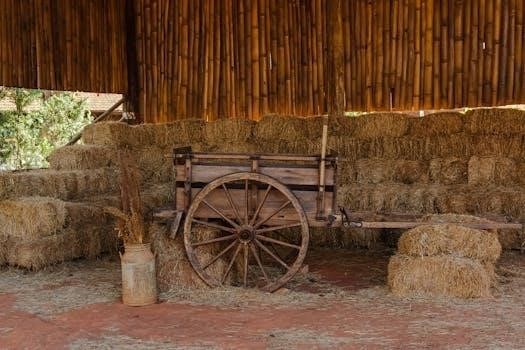
carb tuning guide
Discover how to fine-tune your motorcycle’s carburetor with our comprehensive DIY
guide. Learn about the critical role of the carburetor in achieving optimal engine
performance and fuel efficiency. This article provides a detailed walkthrough of
each component.
Understanding Carburetor Basics
The carburetor’s primary function is to mix air and fuel in the correct ratio to create
a combustible mixture for the engine. It achieves this through various jets and
circuits, each responsible for different engine operating conditions; Understanding
these circuits is crucial for effective tuning. The pilot jet controls fuel flow at idle,
while the needle jet and jet needle manage the mid-range. The main jet governs fuel
delivery at high RPMs. A properly tuned carburetor ensures optimal power, fuel
efficiency, and smooth engine operation. Recognizing how each component interacts
is the first step to mastering carburetor tuning.

Essential Tools for Carb Tuning
Before diving into carburetor tuning, ensure you have the necessary tools. A
selection of screwdrivers, both flathead and Phillips, is essential for adjusting
various screws. A set of jet reamers or numbered drill bits will aid in modifying
jet sizes. A carburetor cleaning kit, including solvent and brushes, is crucial for
maintaining cleanliness. A vacuum gauge helps diagnose vacuum leaks, while a
tachometer assists in setting idle speed. An exhaust gas analyzer provides precise
feedback on air-fuel ratios. Finally, a notebook and pen are invaluable for
recording adjustments and their effects. With the right tools, carburetor tuning
becomes a more precise and efficient process.

Initial Carburetor Setup
Your AED Carburetor is hand built, test run and double checked for performance
right out of the box. Typically the idle speed is the only adjustment needed
however this short reference guide is intended to explain.
Checking for Vacuum Leaks
Assuming your timing and dwell are set, there are no vacuum leaks, the engine is
otherwise mechanically sound, and any gross carburetor problems have been corrected
via the previous troubleshooting guide, you can now proceed to fine-tune the
carburetor. While it may seem trite, most driveability issues stem from basic
problems that are often overlooked. Vacuum leaks can introduce unmetered air into
the engine, disrupting the fuel-air mixture and causing poor idling, hesitation,
or lean running conditions. Thoroughly inspect all vacuum lines, intake manifold
gaskets, and carburetor base gaskets for any signs of cracks, looseness, or
damage. Use a vacuum gauge or propane torch to pinpoint the source of any leaks.
Setting the Float Level
The float level in your carburetor is crucial for maintaining the correct fuel level
in the fuel bowl. An improperly set float level can lead to either a rich or lean
fuel mixture, negatively impacting engine performance. Too high of a float level can
cause fuel to spill into the carburetor throat, resulting in a rich condition, while
too low of a float level can starve the engine of fuel, leading to a lean
condition. Consult your carburetor’s specifications for the correct float level
setting. Carefully adjust the float level by bending the float arm until the float
sits at the specified height when the fuel bowl is inverted.

Idle Mixture Adjustment
Fine-tuning the idle mixture ensures smooth running at low speeds. The goal is to
adjust the carburetor to the “lean-best” setting. This sweet spot optimizes
combustion, balancing fuel efficiency and responsiveness.
Locating the Idle Mixture Screws
Finding the idle mixture screws is the first step in adjusting your carburetor’s
idle. On Holley carbs, they are typically located on the metering blocks,
positioned on either side of the main body. You’ll usually find either two or
four screws.
For Edelbrock carburetors, these screws are generally found on the front side of
the carburetor. Remember to consult your carburetor’s specific documentation or
a repair manual for precise locations, as designs can vary slightly between
models. Identifying these screws correctly is essential for accurate idle mixture
adjustments.
Lean-Best Idle Adjustment Method
When adjusting a carburetor idle screw, the goal is to achieve the
“lean-best” setting. Start by turning the idle mixture screws inward
(clockwise) to lean the mixture until the engine begins to stumble or run
roughly. Then, slowly turn the screws outward (counter-clockwise), enriching
the mixture, until the engine speed peaks and smooths out. Continue turning
outward slightly beyond the peak until the engine speed just begins to drop
again. This point represents the lean-best setting, where the engine idles
smoothly and efficiently. This method ensures optimal fuel economy and
reduces emissions at idle.
Off-Idle and Mid-Range Tuning
Fine-tune your carburetor for optimal off-idle and mid-range performance. Focus
on pilot jet selection and needle adjustments to achieve smooth transitions
and responsive throttle control. A well-tuned mid-range ensures enjoyable
riding.
Pilot Jet Selection and Adjustment
The pilot jet plays a crucial role in the off-idle to low-midrange performance of
your engine. Selecting the correct pilot jet size is essential for smooth
transitions and responsive throttle. An air screw out more than two turns
indicates a need for a smaller pilot jet, while a screw turned in less than
half a turn suggests a larger jet.
Adjust the pilot screw gently, as the seats are delicate and can be damaged by
over-tightening. Measure adjustments in 360-degree turns from the fully seated
position. Fine-tune the pilot screw to achieve a lean-best idle setting for
optimal performance.
Needle Jet and Jet Needle Adjustments
The needle jet and jet needle work together to control fuel delivery in the
mid-range throttle positions. Adjusting these components can fine-tune your
engine’s response and power delivery. Experiment with different needle clip
positions to alter the fuel mixture. Raising the clip lowers the needle, leaning
out the mixture, while lowering the clip richens it.
If you experience hesitation or bogging in the mid-range, consider adjusting the
needle. Be sure to make small, incremental changes and test the engine’s
performance after each adjustment. The goal is to achieve a smooth and
responsive throttle throughout the mid-range.

High-RPM Tuning
Tuning at high RPMs primarily involves selecting the correct main jet. This affects
the amount of fuel introduced into the engine. Achieve optimal power and prevent
lean conditions by carefully selecting the appropriate main jet size.
Main Jet Selection
Selecting the correct main jet is crucial for achieving optimal performance at high
RPMs. The main jet primarily controls the fuel mixture when the throttle is wide
open, typically above 3/4 throttle. A lean mixture at high RPMs can lead to engine
damage, while a rich mixture can result in reduced power and poor fuel economy. To
select the proper main jet, start with the manufacturer’s recommendation.
Gradually increase or decrease the jet size based on your engine’s response.
Monitor spark plug color for signs of lean or rich conditions. Adjustments should be
made in small increments, carefully testing after each change to ensure the engine
runs smoothly and efficiently at high RPMs.
Troubleshooting Common Carburetor Problems
Many driveability issues are caused by poor tuning rather than mechanical faults
within the carburetor itself. Begin by ensuring there are no vacuum leaks and that
the timing and dwell are correctly set. Common symptoms of a poorly tuned
carburetor include rough idling, hesitation during acceleration, and poor fuel
economy. A lean mixture can cause the engine to die, while a rich mixture can lead
to black smoke from the exhaust. Addressing gross carburetor problems using
previous troubleshooting steps is essential before fine-tuning. Correcting these
issues often resolves many perceived carburetor problems, leading to smoother
engine performance.
Advanced Carb Tuning Considerations
For extreme environments like dune riding or ice racing, carburetor tuning changes
may be necessary due to variable loads. Discuss carburetor selection with a
qualified technician for optimal performance in specific applications.
Camshaft Duration and Carburetor Selection
Selecting the right carburetor often depends on camshaft duration at 0.050in of valve
lift. Consider the intake manifold type, whether dual plane or single plane. Also,
factor in the transmission type (manual or automatic) and stall speed. It’s best to
discuss carburetor selection with a qualified technician.
Amateur tuners face obstacles, including mechanical soundness of the engine. Assuming
proper timing and absence of vacuum leaks are critical. Gross carburetor issues should
be corrected before fine-tuning. Remember, carburetors don’t mechanically change tune
nor sense load.
Adjustments for Extreme Environments
For extreme environments like dune riding or ice racing, tuning changes are necessary.
These environments present variable loads. Carburetors don’t mechanically adjust or
sense load.
Consider specific applications like snowbiking or Supermoto. In these conditions,
adjustments are vital. These adjustments are general steps. Drag pipes, particularly
large diameter ones, can hinder optimal carburetor performance. Note that tuning
mainly involves altering fuel introduction. A lean mix can stall the engine.
Discuss with technicians for proper carburetor selection. They can provide guidance.
Remember to address mechanical issues beforehand.


Leave a Reply
You must be logged in to post a comment.